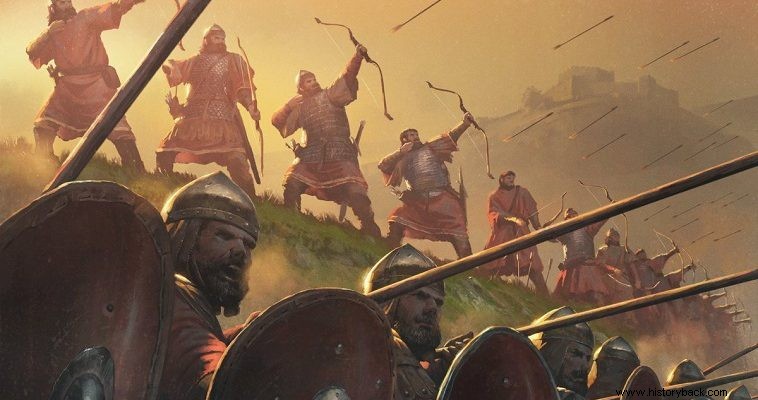
Nikiphoros Phokas, in order to face the Bulgarian threat on the northern borders of the Byzantine Empire, called the Russian ruler Sviatoslav for help. He accepted with enthusiasm and invaded Bulgaria in AD 968
The Bulgarian Tsar Peter then accepted the terms of the Byzantines and capitulated. But the initial success whetted the appetite of the Russian ruler who decided to come back and conquer Bulgaria on his behalf. So it happened. The Russians easily conquered Bulgaria in 969.
Then the mistake of Nikephoros was seen as now the Empire instead of the Bulgarians now had a new, rude and incomparably stronger potential enemy in the north. In the meantime Fokas was murdered by his nephew Ioannis Tsimiskis who spread the word about the Russian threat and decided to face it. For this purpose, he ordered the Domestic of the Schools (commander of the guard) and his close relative, General Vardas Skliros, to find out Sviatoslav's intentions and, if necessary, fight him.
The Russians are rushing south
At the same time the Russians, together with Bulgarians and Pechenegs and Magyars, captured and plundered Philippopolis and invaded Thrace. They bypassed the well-fortified Adrianople and turned towards Constantinople, possibly to spy on the city and "measure" the forces of the Byzantines.
The exact number of men in the Russian army is not known. Skylitzis writes that the head of the invasion force was Svyatoslavos himself and that he had 308,000 men, an unreal number. On the contrary, Leo the Deacon mentions a force of 30,000 men.
The Cruel Misleads
While the Russians were marching into Thrace, Vardas Skleros did not remain idle. At the head of a force of 10-12,000 men he marched to meet the enemy. Leon Diakonos mentions that the Byzantine general sent forward a detachment of light cavalry, under John Alakaseus, to watch the Russians. On the contrary, Skylitzis mentions that Vardas deployed his forces near the walls of Arkadioupolis, with the Russians encamped nearby.
He states that the Russians challenged the Byzantines to battle or duels, but Vardas Scleros did not respond to the challenges. Thus the Russians were convinced that the morale of the Byzantines had fallen to such an extent that they trembled to face them. Consequently they dispersed their forces and began to plunder the surroundings.
In this way Scleros "put the Russians to sleep". A few days later, however, he moved against them. The Byzantine general, due to the numerical superiority of his opponents, used the mind over force. So he divided his small force into three divisions, two of which he placed in an ambush and himself in charge (Skylitzis mentions that Alakaseas was in charge) of only 2-3,000 men moved against the enemies.
In the spider's web
When the Byzantines approached the Russian camp they were the first to move against the Pecheneg light cavalry of the Russian army. The Byzantines pretended to retreat. The Pechenegs pursued them in uncoordinated fashion. But the Byzantines turned their front and counterattacked, causing heavy losses to his pursuers until then.
This maneuver was repeated several times. By the time the Pechenegs became aware of the Byzantines' strategy, many of their men had been killed. Pursuing the Byzantines, the Pestenegos separated from the rest of the Russian army and suffered heavy losses although they fought bravely.
In fact, one Pecheneg managed to strike a terrible blow with his sword on the helmet of Varda the Hard, but it survived, reports Leo Diakonos. Varda's brother Konstantinos mercilessly slaughtered the said Pestenego soon after.
When the rest of the Russian force arrived at the site, the Byzantines again retreated to the ambush site. Suddenly Vardas ordered the trumpets to sound. It was the motto... The Byzantines in ambush rushed out invoking the name of Jesus Christ and fell upon their unsuspecting opponents.
The rest of the Pechenegs who were almost surrounded were the first to be slaughtered. The survivors fled in disorder, causing confusion and panic among the other Russian forces as well. Vardas himself overtook one of the leaders of the Pechenegs and with a terrible blow with his sword cut him in two from the shoulder to the belly!
Chaos ensued. The Bulgarians were the first to panic and, throwing away their weapons, sought salvation in flight. The Bulgarians in turn transmitted the panic to the Russians, and before long the whole barbarian army had turned into a herd of fugitives. The Byzantine horsemen pursued them and massacred them without mercy.
The magnitude of the victory is also evidenced by the disproportion in the losses. The Byzantines had 25 (Skylitzis) or 55 dead (Leon Diakonos) against 20,000 of their opponents, many of whom were trampled among themselves. Despite the great victory, however, the Empire was not yet freed from the Russian danger. It took a new campaign under the emperor Tsimiskis himself and the crushing of the Russians at Dorystolo to remove the insatiable Saviatoslav from the area and then meet his death, during the retreat, with Byzantine... mediation.
